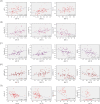Xiang Study: an association of breastmilk composition with maternal body mass index and infant growth during the first 3 month of life
- PMID: 34093977
- PMCID: PMC8155227
- DOI: 10.4162/nrp.2021.15.3.367
Xiang Study: an association of breastmilk composition with maternal body mass index and infant growth during the first 3 month of life
Abstract
Background/objectives: This study aimed to establish a mother and child cohort in the Chinese population, and investigate human breastmilk (HBM) composition and its relationship with maternal body mass index (BMI) and infant growth during the first 3 mon of life.
Subjects/methods: A total of 101 Chinese mother and infant pairs were included in this prospective cohort. Alterations in the milk macronutrients of Chinese mothers at 1 mon (T1), 2 mon (T2), and 3 mon (T3) lactation were analyzed. HBM fatty acid (FA) profiles were measured by gas chromatography (GC), and HBM proteomic profiling was achieved by matrix-assisted laser desorption/ionization time-of-flight (MALDI-TOF) mass spectrometry (MS).
Results: During the first 3 mon of lactation (P < 0.05), significant decreases were determined in the levels of total energy, fat, protein, and osteopontin (OPN), as well as ratios of long-chain saturated FA (including C16:0, C22:0 and C24:0), monounsaturated FA (including C16:1), and n-6 poly unsaturated FA (PUFA) (including C20:3n-6 and C20:4n-6, and n-6/n-3). Conversely, butyrate, C6:0 and n-3 PUFA C18:3n-3 (α-linolenic acid, ALA) were significantly increased during the first 3 mon (P < 0.05). HBM proteomic analyses distinguished compositional protein differences over time (P = 0.001). Personalized mother-infant analyses demonstrated that HBM from high BMI mothers presented increased total energy, fat, protein and OPN, and increased content of n-6 PUFA (including C18:3n-6, C20:3n-6 and n-6/n-3 ratio) as compared with low BMI mothers (P < 0.05). Furthermore, BMI of the mothers positively correlated with the head circumference (HC) of infants as well as the specific n-6 PUFA C20:3n-6 over the 3 time points examined. Infant HC was negatively associated with C18:0.
Conclusion: This study provides additional evidence to the Chinese HBM database, and further knowledge of FA function. It also helps to establish future maternal strategies that support the healthy growth and development of Chinese infants.
Keywords: Humans; body mass index; breast feeding; fatty acids; growth; milk.
©2021 The Korean Nutrition Society and the Korean Society of Community Nutrition.
Conflict of interest statement
Conflict of Interest: The authors declare no potential conflicts of interests.
Figures





Similar articles
-
The association between human milk fatty acid composition in mothers with an elevated body mass index and infant growth changes.Clin Nutr. 2024 Jan;43(1):203-210. doi: 10.1016/j.clnu.2023.11.028. Epub 2023 Nov 27. Clin Nutr. 2024. PMID: 38071941
-
Impact of a high-fat diet on the fatty acid composition of the retina.Exp Eye Res. 2020 Jul;196:108059. doi: 10.1016/j.exer.2020.108059. Epub 2020 May 5. Exp Eye Res. 2020. PMID: 32387380
-
Maternal grazing on stubble and Mediterranean shrubland improves meat lipid profile in light lambs fed on concentrates.Animal. 2018 Jul;12(7):1547-1554. doi: 10.1017/S1751731117003263. Epub 2017 Dec 4. Animal. 2018. PMID: 29198243
-
Effect of dietary intake of n-6 and n-3 fatty acids on the fatty acid composition of human milk in North America.J Pediatr. 1992 Apr;120(4 Pt 2):S87-92. doi: 10.1016/s0022-3476(05)81241-7. J Pediatr. 1992. PMID: 1560330 Review.
-
Food use and health effects of soybean and sunflower oils.J Am Coll Nutr. 1991 Oct;10(5):406-28. doi: 10.1080/07315724.1991.10718168. J Am Coll Nutr. 1991. PMID: 1955619 Review.
Cited by
-
An expert panel on the adequacy of safety data and physiological roles of dietary bovine osteopontin in infancy.Front Nutr. 2024 Jun 11;11:1404303. doi: 10.3389/fnut.2024.1404303. eCollection 2024. Front Nutr. 2024. PMID: 38919388 Free PMC article. Review.
-
Human Milk Macronutrients and Child Growth and Body Composition in the First Two Years: A Systematic Review.Adv Nutr. 2024 Jan;15(1):100149. doi: 10.1016/j.advnut.2023.100149. Epub 2023 Nov 18. Adv Nutr. 2024. PMID: 37981047 Free PMC article.
-
Metagenomic assessment of the bacterial breastfeeding microbiome in mature milk across lactation.Front Pediatr. 2024 Jul 18;11:1275436. doi: 10.3389/fped.2023.1275436. eCollection 2023. Front Pediatr. 2024. PMID: 39092171 Free PMC article.
-
Maternal adiposity moderates associations between dietary, serum, and human milk n-3 and n-6 PUFA.Sci Rep. 2025 May 12;15(1):16489. doi: 10.1038/s41598-025-00940-4. Sci Rep. 2025. PMID: 40355569 Free PMC article.
References
-
- Lanigan J, Singhal A. Early nutrition and long-term health: a practical approach. Proc Nutr Soc. 2009;68:422–429. - PubMed
-
- Ziegler EE. Growth of breast-fed and formula-fed infants. Nestle Nutr Workshop Ser Pediatr Program. 2006;58:51–59. discussion 59–63. - PubMed
-
- Ong KK, Emmett P, Northstone K, Golding J, Rogers I, Ness AR, Wells JC, Dunger DB. Infancy weight gain predicts childhood body fat and age at menarche in girls. J Clin Endocrinol Metab. 2009;94:1527–1532. - PubMed
-
- Belkind-Gerson J, Carreón-Rodríguez A, Contreras-Ochoa CO, Estrada-Mondaca S, Parra-Cabrera MS. Fatty acids and neurodevelopment. J Pediatr Gastroenterol Nutr. 2008;47 Suppl 1:S7–S9. - PubMed
LinkOut - more resources
Full Text Sources
Research Materials
Miscellaneous

